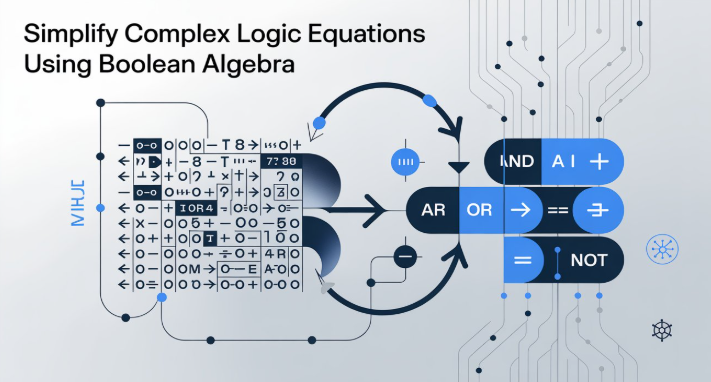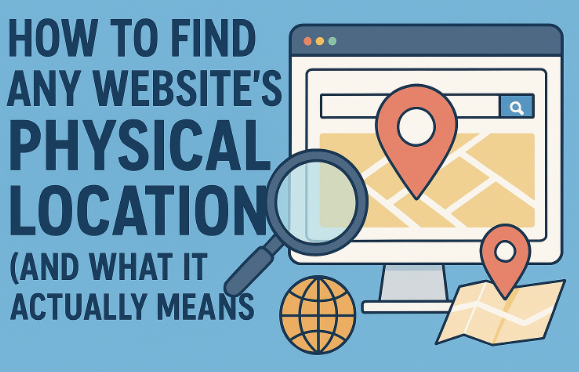Simplify Complex Logic Equations Using Boolean Algebra
Boolean algebra is a branch of algebra that works with only two values, 1(true) and 0 (false), and replaces arithmetic operations with logical ones. It uses logical operations such as AND, OR, and NOT to process information and make logical decisions. The main purpose of Boolean algebra is to simplify complex logical equations into equivalent, shorter, and easier-to-understand forms, preserving the exact same logical output.
This makes it an important concept in digital circuit design, computer programming, and data processing. By reducing long equations into simpler ones, engineers and students can save time, improve system performance, and design more efficient logical systems.
In this blog, we’ll explore how Boolean Algebra helps simplify complex logic equations, why this simplification is important in modern digital systems, and how you can apply it to make your own logic problems easier to solve.
What is Boolean Algebra?
This is a mathematical framework that simplifies complex operations into true (1) and false (0). It was developed by the British mathematician George Boole in the mid-1800s. It works with truth values and the logical relationships between them, rather than traditional algebra, which deals with numbers.
Boolean Algebra is based on three fundamental operations that represent the core logic functions used in digital systems. Here’s a simple overview of each:
1. AND (Conjunction)
This operation represents the logical “AND” function. It gives a result of true (1) only when all inputs are true. In Boolean Algebra;
“The AND operation is usually shown using a dot (·) symbol, like A·B or sometimes just by writing the variables together (AB).”
The truth table for the AND operation is as follows:
2. OR (Disjunction)
The OR operation represents the logical “OR” function. It produces a result of true (1) if at least one of the inputs is true. In Boolean Algebra;
“The OR operation is usually written using the plus (+) symbol (A + B).”
The truth table for the OR operation is shown below:
3. Not (Negation)
The NOT operation reverses the value of its input. If the input is true (1), the output becomes false (0), and if the input is false (0), the output becomes true (1). In Boolean Algebra;
“The NOT operation is usually shown using an overbar (Ā) or a prime symbol (A’).”
The truth table for the NOT operation is as follows:
Fundamental Laws and Theorems of Boolean Algebra
To simplify complex logic equations, you need to understand some basic laws. These laws act like shortcuts that help you reduce the size of an equation while keeping it logically correct. Here are the most commonly used ones:
| Law | Formula | Example / Meaning |
| Identity Law | A + 0 = A, A·1 = A | Adding 0 or multiplying by 1 doesn’t change A |
| Null Law | A + 1 = 1, A·0 = 0 | Anything OR 1 = 1; AND 0 = 0 |
| Idempotent Law | A + A = A, A·A = A | Repeating doesn’t change the result |
| Complement Law | A + A’ = 1, A·A’ = 0 | A and NOT A cancel each other |
| Commutative Law | A + B = B + A | Order of variables doesn’t matter |
| Associative Law | (A + B) + C = A + (B + C) | Grouping doesn’t affect the result |
| Distributive Law | A(B + C) = AB + AC | Works like a normal algebra distribution |
| Absorption Law | A + AB = A | Redundant terms can be removed |
| De Morgan’s Theorem | (AB)’ = A’ + B’, (A + B)’ = A’B’ | Converts AND ↔ OR and complements both sides |
How to Simplify Logic Equations
You can simplify complex logic equations quickly with Boolean Algebra Calculator. But to understand how to do manual calculation, let’s look at a few manual examples that show how Boolean Algebra simplifies logical expressions.
Example 1:
Simplify the following Boolean expression:
~((~A+B) (~B+C))
Simplification:
Step 1: Apply De Morgan’s Law
The rule says:
~(X·Y) = ~X + ~Y
So,
~ ((~A + B) (~B + C)) = ~ (~A + B) + ~ (~B + C)
Step 2: Apply De Morgan’s Law again on both parts
~ (~A + B) = ~~A · ~B = A · ~B
~ (~B + C) = ~~B · ~C = B · ~C
Now the expression becomes:
(A · ~B) + (B · ~C)
Step 3: This expression cannot be simplified further using basic laws, so the final simplified form is:
F = A~B + B~C
Final Answer:
F = A~B + B~C
Boolean Table:
| A | B | C | -A | (-A+B) | -B | (-B+C) | ((-A+B)*(-B+C)) | -((-A+B) *(-B+C)) |
| 0 | 0 | 0 | 1 | 1 | 1 | 1 | 1 | 0 |
| 0 | 0 | 1 | 1 | 1 | 1 | 1 | 1 | 0 |
| 0 | 1 | 0 | 1 | 1 | 0 | 0 | 0 | 1 |
| 0 | 1 | 1 | 1 | 1 | 0 | 1 | 1 | 0 |
| 1 | 0 | 0 | 0 | 0 | 1 | 1 | 0 | 1 |
| 1 | 0 | 1 | 0 | 0 | 1 | 1 | 0 | 1 |
| 1 | 1 | 0 | 0 | 1 | 0 | 0 | 0 | 1 |
| 1 | 1 | 1 | 0 | 1 | 0 | 1 | 1 | 0 |
Graph:
Example 2:
Simplify the Expression
F = (A + BC) (B + A’C)
Simplification
Step 1: Expand using Distributive Law
Apply the Boolean distributive law:
F = (A + BC) (B + A’C)
= A·B + A·A’C + BC·B + BC·A’C
Step 2: Simplify each term
A·A’C = 0 → (Because A and A’ can’t be true together)
BC·B = BC → (Because B·B = B)
So now:
F = AB + 0 + BC + BCA’
F = AB + BC + BCA’
Step 3: Simplify further
Notice that BC + BCA’ can be simplified by taking BC common:
F = AB + BC (1 + A’)
But (1 + A’) = 1 (because anything ORed with 1 is 1).
So:
F = AB + BC
Boolean Algebra Table
| A | B | C | Ā | (A+Ā) | ((A+Ā) *B) | (A+C) | (((A+Ā) *B) *(A+C)) |
| 0 | 0 | 0 | 0 | 0 | 0 | 0 | 0 |
| 0 | 0 | 0 | 1 | 1 | 0 | 0 | 0 |
| 0 | 0 | 1 | 0 | 0 | 0 | 1 | 0 |
| 0 | 0 | 1 | 1 | 1 | 0 | 1 | 0 |
| 0 | 1 | 0 | 0 | 0 | 0 | 0 | 0 |
| 0 | 1 | 0 | 1 | 1 | 1 | 0 | 0 |
| 0 | 1 | 1 | 0 | 0 | 0 | 1 | 0 |
| 0 | 1 | 1 | 1 | 1 | 1 | 1 | 1 |
| 1 | 0 | 0 | 0 | 1 | 0 | 1 | 0 |
| 1 | 0 | 0 | 1 | 1 | 0 | 1 | 0 |
| 1 | 0 | 1 | 0 | 1 | 0 | 1 | 0 |
| 1 | 0 | 1 | 1 | 1 | 0 | 1 | 0 |
| 1 | 1 | 0 | 0 | 1 | 1 | 1 | 1 |
| 1 | 1 | 0 | 1 | 1 | 1 | 1 | 1 |
| 1 | 1 | 1 | 0 | 1 | 1 | 1 | 1 |
| 1 | 1 | 1 | 1 | 1 | 1 | 1 | 1 |
Final Words
Simplifying complex logic equations using Boolean Algebra is one of the best methods in mathematics and computer science. It turns long and confusing logical statements into short and clear ones. It helps in creating faster and smarter systems.
By learning Boolean laws and applying them step by step, you can simplify your complex equations and understand how logical systems work.
















2 Responses
A powerful share, I simply given this onto a colleague who was doing a little evaluation on this. And he in reality bought me breakfast because I found it for him.. smile. So let me reword that: Thnx for the deal with! However yeah Thnkx for spending the time to discuss this, I really feel strongly about it and love studying extra on this topic. If doable, as you turn out to be experience, would you thoughts updating your weblog with extra particulars? It is extremely useful for me. Massive thumb up for this weblog post!
A concise and well-structured explanation of simplifying logic equations. The step-by-step clarity makes complex concepts feel far more approachable.